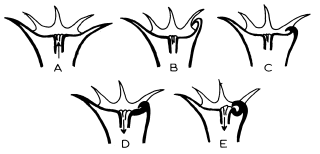Feeding
Anemones are opportunistic carnivores that catch prey as it swims or drifts into their tentacles or oral disc. Prey is then immobilised by a combination of mucous, stinging nematocysts, and sticky spirocysts (Ruppert, 2004). C. polypus feeds on a variety of small prey including crustaceans, molluscs, annelids, copepods, and fish. (Davie, 2011)
Once the tentacles have captured the prey, they then bend towards the oral disc and push the prey into the mouth. Small planktonic prey is ingested by moving the prey to the tip of the tentacle, allowing the anemone to then bend the tentacles into the mouth (Ruppert, 2004).

|
Figure 1: Feeding behaviour sequence. A - Before the anemone encounters a prey item, the tentacles are extended and the pharyngeal ciliary current through the siphonoglyphs is directed out of the coelenteron (arrow). B – After prey contact. Prey held by discharged spirocysts and basitrichs. Tentacle begins to fold toward mouth and shortens. C –Localised contraction of longitudinal muscles of the tentacle, and the oral disc. D – Mesenterial retractor muscle contracts. E – Mouth protrudes towards prey. Chemical signals from prey causes mouth to swell and reversal of ciliary current in order to bring prey into mouth. Adapted from (Shick, 1991).
|
The feeding behaviour observed in the video below is as follows: the initial ‘snatch’ - referring to the immediate response of one or more tentacles to contact with prey, which then adhere to it and retract sharply; the tentacular response – expansion of the oral disc with writing and contraction of tentacles; and the oral response – swelling of the circum-oral area followed by mouth opening and ingestion. (Shick, 1991)
|
|
|
Video of feeding behaviour of Calliactis polypus. Calliactis polypus was fed 3 deceased hermit crabs from another student's experiment. Sped up 2x.
|
Once in the mouth, the prey is the mixed with mucous and swallowed by the pharynx through peristalsis and ciliary action. The prey then enters the coelenteron where it comes into contact with the cnidoglandular bands of the septa. Digestion of the prey then occurs through extracellular digestion, which is instigated by nematocyst discharge and enzyme release, and broken down to particles and molecules for phagocytic uptake (Ruppert, 2004).
The anemone’s diet is supplemented by photosynthate produced by zooxanthellae. The photosynthate produced by the algae can sometimes account for up to 90% of the anemone’s nutrition, depending on the amount of prey available. (Ruppert, 2004)
|